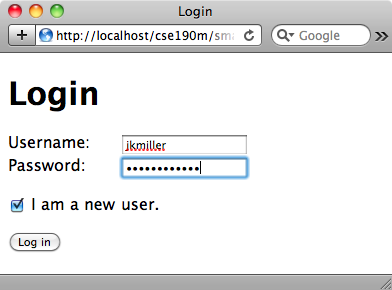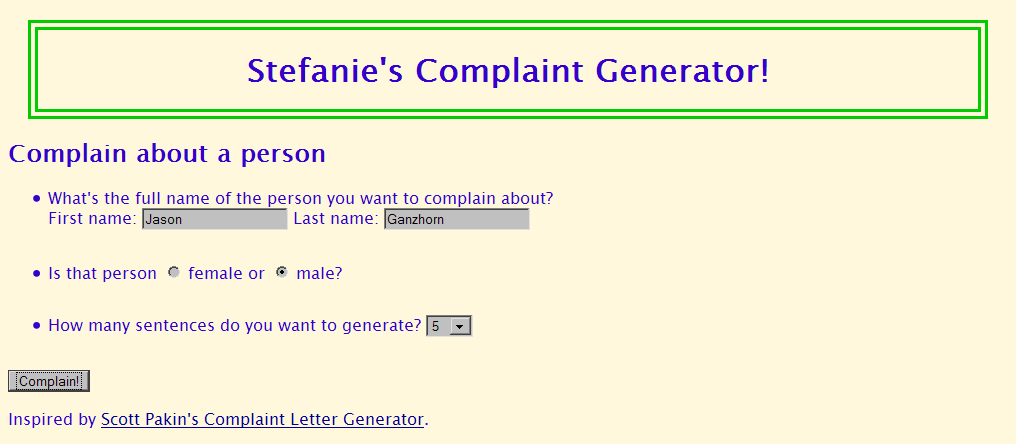University of Washington CSE 154
Section 4: Forms
Except where otherwise noted, the contents of this document are Copyright © Marty Stepp, Jessica Miller, and Victoria Kirst. All rights reserved. Any redistribution, reproduction, transmission, or storage of part or all of the contents in any form is prohibited without the author's expressed written permission.
Exercise : Buggy HTML Form
The following HTML form has several mistakes that causes it not to submit its data correctly, as well as some poor design choices that make it unpleasant to the user. Look at the form, find the bug(s), and correct the problems.
<form action="wherever.php"> UW NetID: <input type="text" id="uwnetid" size="8" /> <br /> Year: <input type="checkbox" name="frosh"> Freshman</input> <label> <input type="checkbox" name="soph" /> Sophomore <input type="checkbox" name="junior" /> Junior <input type="checkbox" name="senior" /> Senior </label> <br /> Student ID number: <!-- don't allow the user to type more than 7 characters --> <input type="text" name="studentid" size="7" /> <br /><br /> Personal statement: Please type a roughly 500-word essay. <br /> <input type="text" name="essay" size="500" /> </form>
Exercise Solution
<form action="http://webster.cs.washington.edu/params.php"> UW NetID: <input type="text" id="uwnetid" size="8" maxlength="8" /> <br /> Year: <label><input type="radio" name="year" /> Freshman</label> <br /> <label><input type="radio" name="year" /> Sophomore </label> <br /> <label><input type="radio" name="year" /> Junior </label> <br /> <label><input type="radio" name="year" /> Senior </label> <br /> Student ID number: <input type="text" name="studentid" size="7" maxlength="7"/> <br /><br /> Personal statement: <br /> <textarea name="essay" rows="10" cols="80"> Please type a roughly 500-word essay. </textarea> </form>
Exercise : Animal Gallery (by Alex Miller)
Given a directory of animal pictures (images.zip), write a PHP webpage animals.php which displays these pictures.
If no query parameter is set, then the page should simply display all of the images in the
images directory. The user can set an animal query parameter to
choose whether to display only puppy pictures or only kitty pictures. For example, if the
user entered the following URL:
animals.php?animal=puppy
Then the page should only display puppy pictures. You may assume that the animal query
parameter is either kitty or puppy.
Exercise Solution
<div>
<?php
$animal = "";
if (isset($_GET["animal"])) {
$animal = $_GET["animal"];
}
$files = glob("images/{$animal}*.jpeg");
foreach ($files as $image) {
?>
<img src="<?= $image ?>" alt="animal picture" />
<?php
}
?>
</div>
Exercise : Login (by Morgan Doocy)
Write a form, login.html, which asks the user
for a username and password. Then write a script, login.php,
that will look in the file passwd.txt to see if the user's password matches.
Each username/password pair will be stored on its own line in the form username:password.
If the password entered matches the password stored in the file for that user, login.php
should display a message with a class of granted. Otherwise, it should display a message
with a class of denied.
If the user checks "I'm a new user", then you should add the provided username and
password to passwd.txt.
Exercise : Login (by Morgan Doocy)
 →
→

Exercise Solution
<!DOCTYPE html> <html> <head> <title>Login</title> <link href="http://webster.cs.washington.edu/cse154/sections/4/login/login.css" type="text/css" rel="stylesheet" /> </head> <body> <h1>Login</h1> <form action="login.php" method="post"> <dl> <dt>Username:</dt> <dd><input type="text" name="username" /></dd> <dt>Password:</dt> <dd><input type="password" name="password" /></dd> </dl> <p><label><input type="checkbox" name="new" /> I am a new user.</label></p> <p><input type="submit" value="Log in" /></p> </form> </body> </html>
Exercise Solution
<?php
$user = $_POST["username"];
$passwd = $_POST["password"];
$new = isset($_POST["new"]);
if ($new) {
file_put_contents("passwd.txt", "$user:$passwd\n", FILE_APPEND);
} else {
$granted = false;
$passwords = explode("\n", file_get_contents("passwd.txt"));
foreach ($passwords as $line) {
list($stored_user, $stored_pass) = explode(":", $line);
if ($entered_user == $stored_user
&& $entered_pass == $stored_pass) {
$granted = true;
break;
}
}
}
?>
Exercise Solution
<!DOCTYPE html>
<html>
<head>
<title>Login</title>
<link rel="stylesheet" type="text/css"
href="http://webster.cs.washington.edu/cse154/sections/4/login/login.css" />
</head>
<body>
<?php if ($new) { ?>
<h1 class="granted">Welcome, <?= $entered_user ?>!</h1>
<?php } else if ($granted) { ?>
<h1 class="granted">Access granted</h1>
<?php } else { ?>
<h1 class="denied">Access denied!</h1>
<?php } ?>
</body>
</html>
Exercise : Show Twos (by Alex Miller)
Write a PHP function show_twos that takes an integer parameter and
outputs its factors of 2 with HTML. For example:
show_twos(68);
show_twos(18);
show_twos(68);
show_twos(120);should produce the following output:
<strong>68</strong> = 2 * 2 * 17<br/>
<strong>18</strong> = 2 * 9<br/>
<strong>68</strong> = 2 * 2 * 17<br/>
<strong>120</strong> = 2 * 2 * 2 * 15<br/>
If you have time, wrap the code in a page that accepts a query parameter num and passes that parameter to the function.
Exercise Solution
<?php
function show_twos($n) { ?>
<strong><?= $n ?></strong> =
<?php
while ($n % 2 == 0) {
print "2 *";
$n = $n / 2;
}
?>
<?= $n ?><br />
<?php
}
show_twos($_GET["num"]);
?>
Exercise : Captions (by Morgan Doocy)
Write a form, caption.html, which asks the user to select a photo to display and two lines of caption. Then write a script, caption.php, that will accept the submitted information and display the photo and captions on-screen:
Provide several photo URLs to select from in the form of a dropdown menu. Give the options in the dropdown user-friendly labels, but make the user's final selection result in an absolute URL being submitted to the server script. For the img's alt text, use a combination of both caption lines.
Exercise : Captions (by Morgan Doocy)
 →
→

Exercise Solution
<form action="caption.php" enctype="multipart/form-data" method="post"> <dl> <dt>Image:</dt> <dd> <select name="image"> <option value="http://tinyurl.com/8x4ouqu">Cupcake</option> <option value="http://tinyurl.com/6uqgufv">Leo Strutting</option> </select> </dd> <dt>Line 1:</dt> <dd><input type="text" name="line1" /></dd> <dt>Line 2:</dt> <dd><textarea name="line2" rows="2" cols="30"></textarea></dd> </dl> <p><input type="submit" value="Captionate!" /></p> </form>
Exercise Solution
<?php $image = $_POST["image"]; $line1 = $_POST["line1"]; $line2 = $_POST["line2"]; ?> <p> <img id="image" src="<?= $image ?>" alt="<?= "$line1. $line2" ?>" /> </p> <h1 id="line1"><span><?= $line1 ?></span></h1> <p id="line2"><?= $line2 ?></p>
Exercise : Calculations (by Alex Miller)
Given an input file input.txt, Write a PHP page calculations.php that reads in the file and calculates the result for each line in the file. For example, the result for the line:
divide:8 2 2
would be:
8 / 2 / 2 = 2
Exercise Solution
<ul><?php
$lines = file("input.txt");
foreach ($lines as $line) {
$split = split(":", $line);
$numbers = split(" ", $split[1]);
$sum = $numbers[0];
for ($i = 1; $i < sizeof($numbers); $i++) {
if ($split[0] == "add") {
$sum += $numbers[$i];
} else if ($split[0] == "multiply") {
$sum *= $numbers[$i];
} else if ($split[0] == "subtract") {
$sum -= $numbers[$i];
} else if ($split[0] == "divide") {
$sum /= $numbers[$i];
}
} ?>
<li><?= $line ?> = <?= $sum ?></li>
<?php } ?></ul>
Exercise : Complaint Generator
Write an HTML form, complaint.html, that
allows the user to generate complaint letters. The user will specify the first/last name of
the person to complain about, the person's gender, and how many sentences of complaints to
generate. Test your form by having it initially submit its data to
params.php. The following should be
the appearance of your form:

Exercise : Complaint Generator
Once your form submits properly, write a PHP page
letter.php on the server to process
this form data. On the server there is a file
sentence.txt containing a bunch of
complaint sentences. Your PHP code should read this file, randomly pick sentences from it,
and turn these into a complaint letter. The file has one sentence per line. You will need
to personalize the letter by inserting the person's name and other information into it.
The following are the patterns you will need to replace:
_FNAME_: person's first name_LNAME_: person's last name_NAME_: person's full name_HESHE_: he (male) or she (female)_HIMHER_: him (male) or her (female)_HISHER_: his (male) or her (female)
Exercise : Complaint Generator
You can use the str_replace function
to help you replace the above patterns in the text. If you write the code correctly, you can
replace each placeholder with a single call. When you're finished with your page, it should
look like the following:

Exercise Solution
Your finished code might look like the following sample solution, written by TA Stefanie Hatcher:

